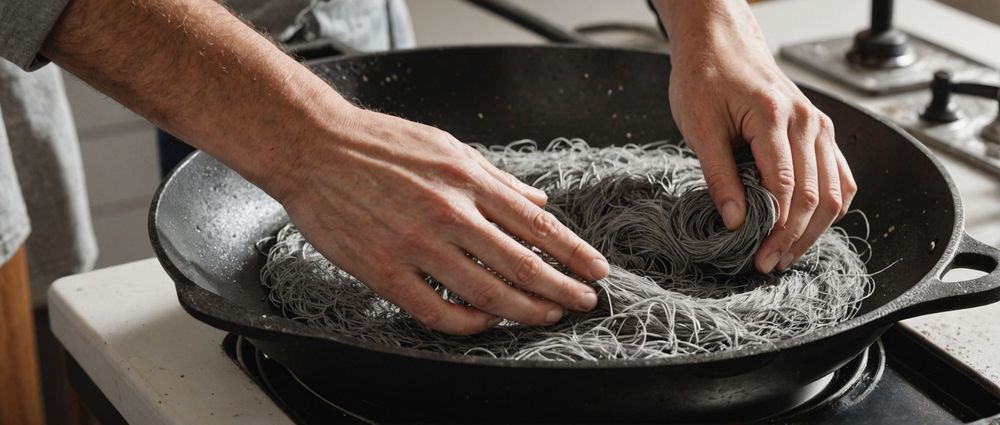If you’ve discovered rust on your cast-iron skillet, don’t worry—it’s a common issue that can be remedied effectively. In this article, we’ll delve into the step-by-step process of removing rust from your skillet, ensuring that you can get back to cooking with your beloved pan. Rust can affect the performance and integrity of your skillet, but with the right techniques, you can restore it to its former glory. We will explore various methods for rust removal, from simple scrubbing to effective chemical treatments, providing you with the knowledge to handle this maintenance task with ease.
Understanding the Causes of Rust
Before addressing how to remove the rust, it’s essential to understand why it happens in the first place. Cast-iron skillets are prone to rust due to their porous nature and the fact that they can rust when exposed to moisture. If the skillet is not properly seasoned or stored, it can become a target for rust formation. Factors contributing to rust include:
- Improper drying after washing.
- Long exposure to moisture or humidity.
- Scratches or wear in the seasoning layer.
- Storing it without sufficient protective oil.
- Using abrasive cleaners that strip away seasoning.
By understanding these causes, you can take proactive measures to prevent future rusting and prolong the life of your skillet.
Tools and Materials Needed

Before tackling the rust removal process, gather the necessary tools and materials to make the job easier. Here’s what you’ll need:
- Steel wool or a scrub pad.
- Sandpaper (fine grit).
- White vinegar or a rust remover.
- Cooking oil (flaxseed, canola, or vegetable oil).
- Paper towels or a clean cloth.
- Oven or stovetop for seasoning.
Having everything organized and within reach will streamline the rust removal process, helping you to focus on effectively restoring your skillet.
Step-by-Step Guide to Removing Rust

Now, let’s dive into the detailed steps you should follow to effectively remove rust from your cast-iron skillet.
1. Clean the Skillet
Start by washing the skillet with hot, soapy water to remove any food residue. Although you typically don’t want to use soap on cast iron, it’s necessary this time as we are addressing rust. Use a scrub pad or steel wool to eliminate any loose rust. Rinse thoroughly and dry the skillet completely with a clean towel to prevent further rusting.
2. Apply Vinegar
Next, pour white vinegar over the rusted areas of the skillet. The acid in the vinegar helps to dissolve rust. Allow the vinegar to sit for about 30 minutes. If the rust is extensive, you can submerge the skillet in a vinegar solution. Be cautious, as prolonged exposure can also harm the cast iron.
3. Scrub the Skillet Again
After the vinegar has worked its magic, take your scrub pad or steel wool and scrub the skillet again. You should notice that the rust is coming off easier. Rinse the skillet with water and dry it completely. Repeat this process if necessary until most, if not all, rust is removed.
4. Season the Skillet
Once the rust has been removed and the skillet is clean, it’s critical to reseason it to restore its protective layer. Preheat your oven to 375°F (190°C). Apply a thin layer of cooking oil to the skillet, both inside and out. Place it upside down in the oven (with a baking sheet underneath to catch drips) and allow it to bake for one hour. Let it cool in the oven to complete the seasoning process.
5. Maintain Your Skillet
To prevent rust from returning, always ensure your skillet is completely dry after washing it. Consider applying a light coat of oil before storing it, and avoid soaking it in water. Using your skillet often will help maintain its seasoning and keep it in good shape.
Conclusion
Removing rust from a cast-iron skillet is not only possible but relatively straightforward when you follow the right steps. By understanding the causes of rust, using the proper tools, and performing regular maintenance, you can keep your skillet in excellent condition for years to come. With your rust troubles behind you, you can return to using your skillet as a versatile cooking tool, enjoying delicious meals that are enhanced by its remarkable heat retention and distribution properties. Remember, the key to a great cast-iron skillet is consistent care—so show your pan some love!
FAQs
1. Can I use salt to remove rust from my skillet?
Yes, you can use salt as a mild abrasive while scrubbing with a little bit of water or vinegar. It’s less harsh than steel wool, but may not be as effective for severe rust.
2. Is it safe to eat from a rusted skillet?
While small amounts of rust won’t harm you, it’s best to remove rust before cooking. Consuming rust is not advisable, as it can lead to an unpleasant taste and potential health risks.
3. How often should I season my cast-iron skillet?
It’s recommended that you season your skillet after every few uses, especially if you notice any dullness in its surface or if you’ve washed it with soap.
4. What’s the best oil for seasoning a cast-iron skillet?
Flaxseed oil is highly recommended for seasoning due to its high smoke point and ability to create a durable seasoning layer. However, other oils like canola, grapeseed, and vegetable oil work well too.
5. Can I put my rusted skillet in the dishwasher?
No, you should avoid putting your cast-iron skillet in the dishwasher as it will strip away the seasoning and promote rust. Always wash by hand with soap only when necessary.